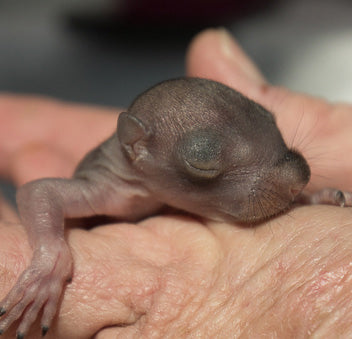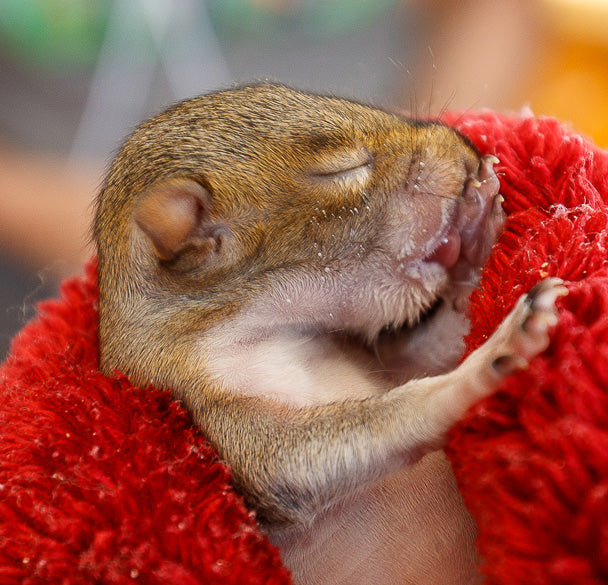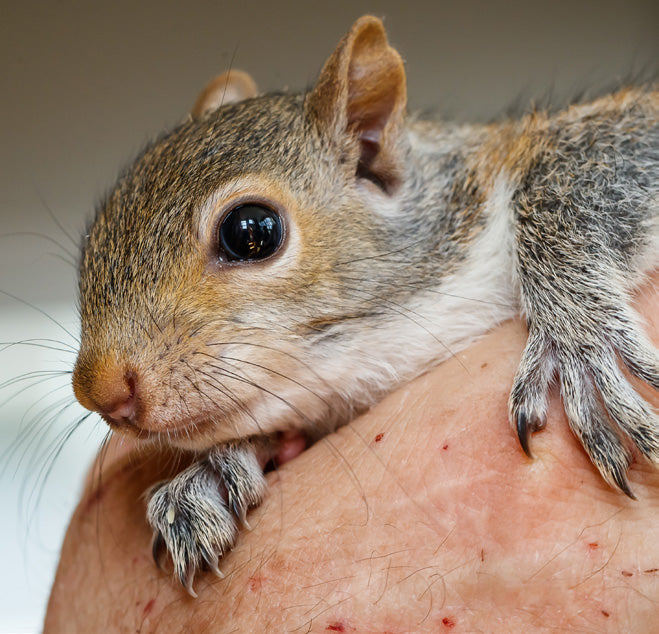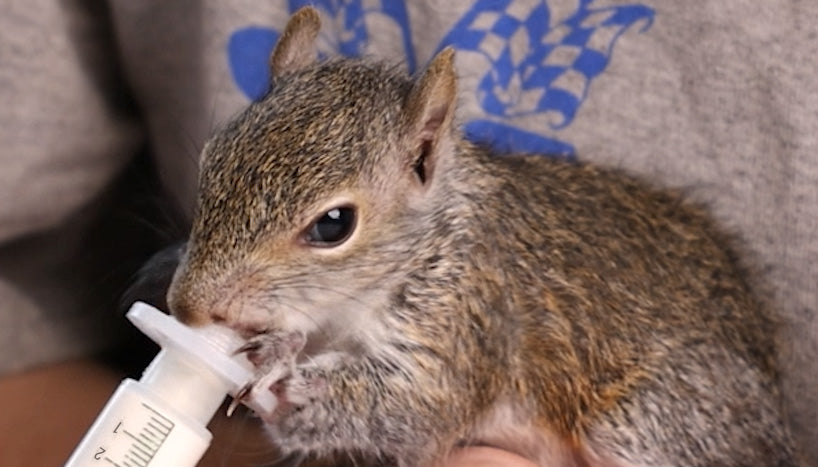Your cart (0)
Your cart is empty
Tax included and shipping calculated at checkout
Drawer menu
Tax included and shipping calculated at checkout
Found a baby squirrel? Don’t panic. Trying to reunite baby squirrels with their mom or placing them in the care of a licensed wildlife rehabilitator (“rehabber”, for short) are always the best options, but we know that sometimes neither is possible. In that case, this step-by-step guide will help you care for a new baby from birth to the introduction to solid food at approximately 6-7 weeks old.
In addition to the information in this guide, Henry’s has convenient, pre-made Baby Squirrel Kits containing most of the items you’ll need to raise a baby, including your choice of rehabber-approved formulas like Fox Valley and Wombaroo, O-ring syringes, nipples, and more.
If you need immediate assistance from an experienced wildlife rehabilitator, please call Henry’s Emergency Help Line at (540) 745-3334 Ext. 1 or (203) 214-7427.
An injured, emaciated, or very dehydrated baby squirrel will need extra care. Please reach out to us or an experienced wildlife rehabber in your area.
1. Are they skinny? A starving baby needs smaller feedings at first, until their stomach recovers from malnutrition.
2 Are they dehydrated? Babies are almost always dehydrated by the time a human finds them. Monitor their urine: it should be clear, odorless, and plentiful. Pinch the skin on their belly and count how many seconds it takes for the skin to go back down flat. 4 seconds or more could be life-threatening.
3. Are they injured? Check for any cuts, bruises, swelling, etc. Contact a wildlife rehabber ASAP for assistance in treating injuries.
4. Check for fly eggs. These look like small grains of beige-colored rice. Remove them immediately or they will hatch into maggots that will eat the baby alive. Carefully the check eyes, inside the ears, and around the anus.

Dark color on head and back, eye slits visible, ears coming away from head.

Thicker fur, eyes almost ready to open, lower teeth emerging.

Fully furred (including belly), eyes open, upper teeth emerging.
Below is a list of items you can buy locally to help get you through until your Henry’s Baby Kit arrives.
1. Large Plastic Container with fleece, flannel, or old t-shirts for bedding.
2. Heating Pad (in a pinch, you can make a "rice buddy", see Step 3).
3. Digital Scale to weigh the baby (you feed according to their weight).
4. O-Ring Syringes to feed with (ask your pharmacist; in a pinch, use an eye dropper).
5. Homemade Goat Milk Formula (HGMF) the safest substitute formula (you'll need eggs, fresh or powdered goat milk, heavy cream, and yogurt — see Step 5 for full recipe).
Warning: Do not use KMR®, human baby formula, condensed milk, scalded milk, GNC® puppy formula, soy/almond/cashew/coconut milk, Pet-Lac®, kitten formula, Whiskas® Cat Milk, Esbilac “Milk Replacer Plus,” breast milk, cow's milk, Kid Milk, etc. They cannot meet the squirrel's dietary requirements and will make them sick!
You can begin warming the baby squirrel in your hands or using a "rice budy" (see insert). To keep the baby warm all night, use a heating pad. Make sure your heating pad does not shut off automatically after 2-3 hours, letting them get cold. You can buy no-auto-shutoff or delayed shutoff heating pads on our website.
A cardboard box can dehydrate them; towels will catch their nails. They will chill and die without a heating pad - heat lamps will dehydrate them and reptile warmers won’t keep them warm enough. Place a heating pad underneath half the container, not inside, to avoid overheating.
Place the baby squirrel on the bedding and cover them with one flap.
Check for Dehydration: You should always assume a baby is dehydrated by the time you find it. Their urine is the best indicator of hydration levels: urine should be clear, odorless, and plentiful. If they are not uringating much or it is dark/smelly, they are dehydrated. You can also pinch the skin on the back of the neck and the belly, then count how many seconds it takes to go back down flat.
Note: This test is not always reliable in very young hairless babies or
emaciated babies. Always assume that every baby squirrel is dehydrated
when you first find them.
Rehabbers should keep Fox Valley Electro-Stat, a powdered electrolyte, on hand. Homemade rehydration fluid is better for squirrels than Pedialyte®, since Pedialyte has a high salt content.
Homemade Rehydration Fluid - See Step 5 for Feeding Instructions
Note: Pedialyte has very high salt content, so if using Pedialyte, dilute it with water (1 part Pedialyte to 1 part water) and add a sweetener, as directed above.
Syringes: Use a quality O-ring syringe (with or without a nipple), 1 mL or 3 mL (cc) size. An eyedropper can also work in a pinch. Never use pet or baby bottles. They will allow formula to flow too quickly and risk aspirating the baby.
How Long to Keep Hydrating? The baby can have as much hydration fluid as they will take. With severely dehydrated babies, offer fluids every half hour. Very weak baby squirrels may only be able to take a few drops at a time, given every 15 minutes. Keep monitoring their urine and doing the pinch test to track your progress
When to Start Feeding Formula? When a baby is dehydrated, their bodies are not capable of digesting formula properly. You want to rehydrate the baby sufficiently before offering formula, which will require more energy from their bodies to digest. You should see the baby “perk up” once the dehydration starts to improve and their urine will be more plentiful and clear. If the baby squirrel isn’t badly dehydrated, you can begin feeding formula within an hour or so. Some babies take closer to 24 hours to fully recover from dehydration.
Once you start formula, continue to give hydration fluid between feedings until the baby passes the dehydration test. Continue to check for several days, as it can take a few days to fully recover and dehydration can come back.
How to Heat the Fluid: Fill a coffee mug with hot water. Fill the syringe with rehydration fluid or forumula and place it in the mug for a couple of minutes. Squirt a drop on the inside of your wrist. It should feel very, very warm but not hot on your skin. You can also mix formula in a small glass container and place it inside a bowl of hot water.
Proper Feeding Position: Hold the baby upright in your hand. A baby that can walk can also drink sitting up or lying on its stomach. Don’t let the baby get cold. Keep them wrapped up while they eat.
Feeding Technique: Place the syringe tip on the baby squirrel’s lips (from the side) and squeeze out one drop for them to taste. Let them swallow one drop before squeezing more. Go slow! It sometimes takes time for them to catch on.
Note: If the baby is firmly latched on to the nipple, never pull the nipple out of the baby’s mouth. This suction can force fluid into the inner ears, causing infection. Allow the baby to let go on their own.
Newborn babies are fed drop by drop. With older babies you can squeeze slowly for one second, wait for them to swallow, then squeeze again. Don’t let the squirrel suck so hard they pull the barrel down; you need control it and
keep it at a slow, easy pace. If fluids dribble out of the mouth or nose, you’re going too fast. Stop and tilt
the baby’s head down so the fluid drains out (support the head and neck).
Then wipe their nose and mouth with a tissue.
Start over, go slower. The baby
could be at risk for aspiration pneumonia, which is fatal unless treated with
antibiotics, and can start vomiting if they are fed too quickly.
Once the baby squirrel is warm and has had some hydration fluid, you are ready to start feeding formula, sometimes called “milk replacer”.
Formula Recommendations for Different Ages:
Make sure the formula is very warm. Baby squirrels will not drink formula that is only slightly warm! We recommend Wombaroo milk replacer for tiny pinkies.
Homemade Goat Milk Formula:
You can buy goat milk at most grocery stores. If you can’t find fresh goat milk, you can use the canned or powdered varieties.
Note: Canned or powdered milk must be mixed with water FIRST according to label directions.If you can’t find goat milk, double the yogurt (6 tablespoons). Always be alert for bloating, diarrhea, or constipation and take immediate action.

Incorrect: Syringe Pointing Down.

Correct: Syringe Pointing Up.
Mixing and Storing Formula
Squirrel weighs 50 grams
50 x 7% = 3.5 (Using a calculator, it's 50 x 0.07 = 3.5)
So you feed 3.5 mL per feeding
The 5-7% Feeding Rule
Weigh the baby on a scale in grams. Multiply their weight by 5% (0.05) and that will be the number of mL’s to feed per feeding. You may need to start with smaller feedings at first and work up to 5%, then eventually 7% after a few feedings, especially for emaciated babies.
Do not overfeed or increase feeding amounts too quickly! Baby squirrels will overeat if you let them and get diarrhea or bloating, which can be fatal. Weigh the baby at the same time every day to determine if they are gaining or losing weight and adjust the formula amount as needed.
Try to continue feeding formula until the baby is at least 16 weeks old. Around 6-7 weeks, you can begin introducing healthy solid foods like Henry's Blocks and healthy vegetables. Never start a baby on nuts and fruits, those should only be given rarely once a baby is at least 4 months old. Read our Weaning Guide for more information.
Potty Time: A baby squirrel less than 5 weeks old will need to be stimulated to poop and pee. Use a warm, wet cotton ball, cotton swab, the corner of a Kleenex, or your finger, and lightly flick across the genital area. Some babies may need stimulation before and after feeding. A few may eat better if you help them potty in the middle of a feeding.
Warning: Don’t use cheap syringes! The plungers can stick and get caught on the way down. This can lead to you pushing too hard and accidentally flooding the baby’s mouth with formula and causing them to aspirate. Use quality O-ring syringes and go slow!
Try to continue feeding formula until at least 16 weeks old. At approximately 6 weeks old, you can start introducing solid foods. See our Weaning Guide for information on introducing foods and safely weaning off formula.
Bloating: Can occur when a baby squirrel eats too much, too often, or from formula intolerance. The stomach should be rounded after feeding, but still soft, like a half-filled water balloon. It should deflate before the next feeding.
If the stomach feels hard or does not deflate: Skip a feeding, hydrate, and decrease the amount of formula at each feeding, or increase the amount of time between feedings. Stimulate the baby to potty. Dipping the baby in warm water up to their armpits and gentle massage can also help.
Clicking (aspiration pneumonia): If formula comes out the baby’s nose, they may have inhaled some, causing aspiration pneumonia. Symptoms include loss of appetite, lethargy, and a clicking noise when the baby breathes. Hold the baby’s chest to your ear and listen carefully. The clicking is with each breath, in and out. This must be treated immediately with antibiotics or the baby will die. Please consult a wildlife rehabilitator or vet for prescription and dosing information.
Constipation: It can take a day or so for the baby to start pooping after starting formula, since they are usually malnourished by the time they are found. If constipation persists, it could mean the baby is still dehydrated. In that case, give them rehydration fluid in a syringe between feedings. If no results within 12 hours, give a little prune juice. Bathe the baby in very warm water, gently massage the belly and anal area while in the water.
Diarrhea: Can be caused by overfeeding, too frequent feeding, poor formula, or parasites. Stop feeding formula for a couple of feedings and hydrate instead. If the baby is less than 4 weeks old, you may need to switch to the Homemade Goat Milk Formula. Diarrhea can kill quickly, so consult a wildlife rehabilitator or vet as soon as possible.
Fly Eggs or Maggots: Fly eggs look like small grains of rice; they will quickly hatch into maggots, crawl into the baby’s eyes, ears, mouth, or anus, and eat them alive. Remove all eggs & maggots immediately and check all orifices. Baby must be treated with Capstar within 24 hours.
You can buy Capstar (11.4 mg) from us, or at your local pet store. Crush 1/4 tablet, dissolve in 1 mL water, and give orally by syringe once a day for two days. In addition, you can crush 1/2 tablet in 2 mL water and apply externally anywhere maggots or eggs are visible, especially ears, nose, eyes, or anus.
Hypoglycemia: Caused by starvation or feeding too little, too infrequently. The baby may arch their back, have spasms, or gasp for breath. Rub molasses, honey, or pancake syrup on its gums. You should see improvement within 30 minutes. Make sure your feeding amounts and schedule are correct.
Feeding Trance: While feeding, some baby squirrels will stop swallowing and open and close their mouth like a fish. This is not harmful but means feeding takes longer. Blowing lightly in their face or a gentle tap on the head can help. When they stop gulping, you can resume feeding.
If a baby squirrel isn't doing well for any reason go back to basics and ask yourself:
Then address the issues in that order.
Nursing on Genitals: Baby squirrels may nurse on genitals when they are housed together, causing redness, swelling, or scabbing on the tip of the penis. This is very serious as it can cause permanent damage to the urethra. Immediately separate the babies. If the baby is self-sucking, you’ll need to apply a bandage until they break the habit. If there’s a scab, soak the area in warm water and gently remove the scab. Then apply some Neosporin®.
Refuses to Feed or Blood on Nipple: Baby squirrels teethe twice: once for upper teeth and once for lower. Teething may cause the baby to suddenly refuse to eat, or eat less than normal, and you may see a little blood. This is normal and should pass after 24 hours. If you are consistently seeing blood, please speak to a rehabber or vet.
Smelly Urine: Urine should not smell when the baby pees; this indicates a urinary tract infection which must be treated with antibiotics. If left untreated, it will cause neurological symptoms, such as head shaking or tilting, loss of balance, etc.
You now know everything you need to raise a generally healthy baby squirrel from birth to approximately 6-7 weeks old, when they should be introduced to solid food. Please see our Weaning Guide for more information.
Should you still need assistance, please call our Emergency Help Line at (540) 745-3334 Ext. 1 or (203) 214-7427. To find a wildlife rehabilitator near you, please check with your state wildlife department.